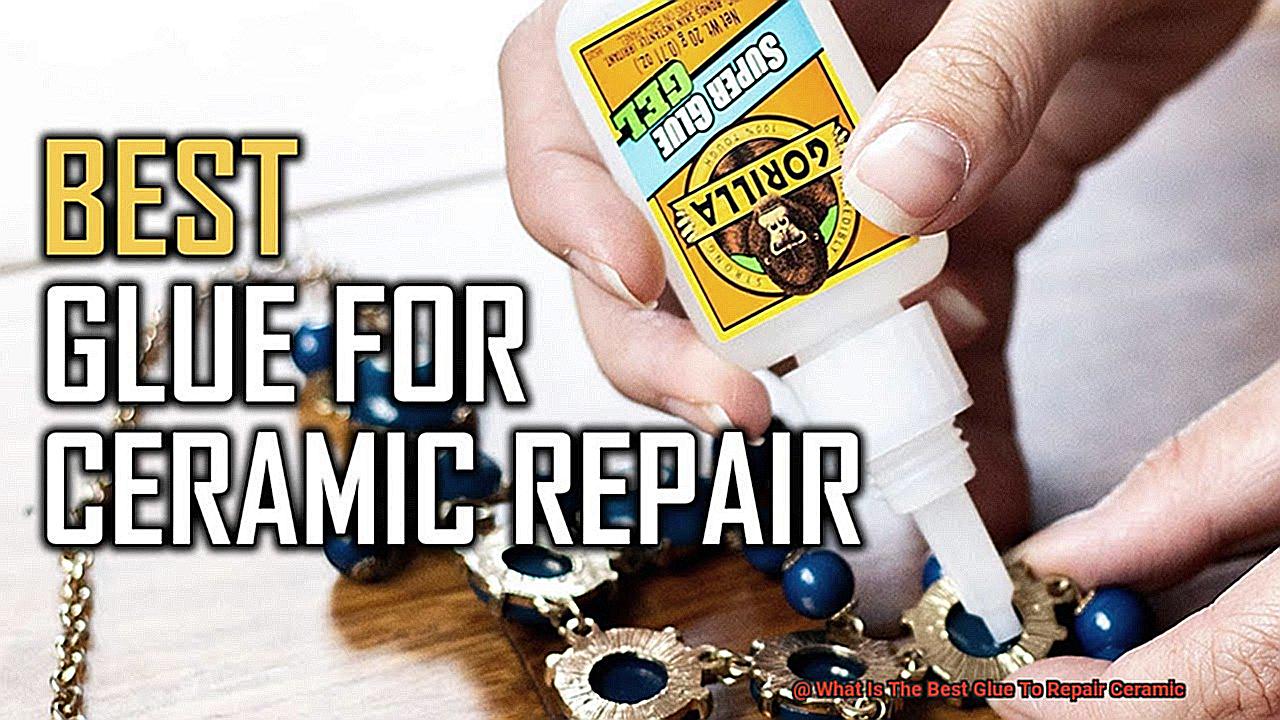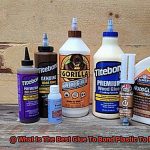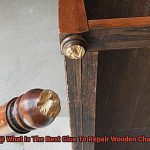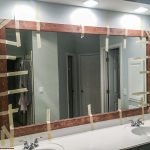Picture this: you’re holding your favorite ceramic mug, savoring that first sip of morning coffee. But then, disaster strikes. The mug slips from your grasp and crashes to the floor, leaving you with a shattered mess. Cue the heartbreak.
But fear not, my friend. There’s a secret weapon in the battle against broken ceramics – the perfect glue. With its incredible power, it can resurrect your shattered treasures and bring them back to life.
Welcome to the captivating world of ceramic repair, where finding the best glue is like discovering a hidden treasure. In this blog post, we’ll dive deep into this crafty art form and reveal the adhesive that will make your repairs stick like magic. So whether it’s a chipped plate or a fragile figurine, I’ve got all the answers you need.
But before we unveil our glue recommendation, let’s take a moment to understand what makes a glue truly worthy of repairing ceramics. We’ll explore the secrets behind this delicate dance between precision and patience, ensuring that your restored masterpieces will withstand the test of time.
Get ready to become a ceramic repair pro – let’s get gluing.
The Benefits of Epoxy Glue for Ceramic Repair
Contents
- 1 The Benefits of Epoxy Glue for Ceramic Repair
- 2 Super Glue: A Quick and Easy Option for Small Repairs
- 3 Polyurethane Glue: A Flexible and Durable Choice
- 4 Specialized Ceramic Adhesives: The Best Option for Seamless Results
- 5 Factors to Consider When Choosing the Best Glue for Ceramic Repair
- 6 Tips for Applying Adhesive to Ceramics
- 7 Common Mistakes to Avoid When Using Glue on Ceramics
- 8 Alternatives to Glue for Ceramic Repairs
- 9 Conclusion
Ceramics are delicate and beautiful, but accidents happen. Luckily, there’s a solution that can bring your broken ceramics back to life – epoxy glue. With its strong bond, durability, and versatility, epoxy glue is the go-to choice for ceramic repair. In this article, we will explore the many benefits of using epoxy glue to mend your favorite ceramic pieces.
Strong and Long-Lasting Bond:
Epoxy glue is renowned for its exceptional bonding strength. Its two-component formula, combining resin and hardener, creates a powerful adhesive that can withstand the test of time. Whether you’re fixing a cracked vase or reattaching a broken handle, epoxy glue ensures a reliable and long-lasting bond. No more worrying about your repaired ceramic piece falling apart again.
Versatility:
Epoxy glue is not limited to ceramic repair alone. It can also be used to mend glass, metal, wood, and other materials. Having a versatile adhesive on hand saves you time and money by allowing you to tackle various DIY projects with confidence. From repairing your favorite ceramic mug to fixing a broken picture frame, epoxy glue has got you covered.
Compatibility with Different Ceramic Types:
Ceramics come in various forms – porcelain, stoneware, earthenware – each requiring a specific adhesive for repair. Epoxy glue surpasses this challenge by bonding effectively with all types of ceramics, making it a universal solution for your restoration needs. Whether it’s a delicate porcelain teapot or a sturdy stoneware bowl, epoxy glue can handle it all.
Seamless Repair:
Epoxy glue dries clear, resulting in an invisible repair that seamlessly blends with the ceramic’s original appearance. Say goodbye to unsightly cracks or blemishes – epoxy glue restores your cherished ceramics to their former glory. Your repaired ceramic pieces will regain their beauty and charm, allowing you to proudly display them once again.
Resistance to Heat and Moisture:
Unlike traditional adhesives that may weaken or dissolve when exposed to high temperatures or moisture, epoxy glue thrives in these conditions. It can withstand extreme temperatures and resist water damage, making it suitable for both indoor and outdoor use. You can confidently use your repaired ceramic items in the dishwasher or place them in the garden without worrying about the adhesive failing.
Filling Gaps and Reinforcing Weak Areas:
Epoxy glue’s versatility extends beyond simple bonding. It can also fill gaps and cracks, reinforcing weak areas in ceramic pieces. Whether you’re revitalizing a chipped teacup or strengthening a fragile figurine, epoxy glue provides the durability and support needed to ensure your ceramics stand the test of time. Your repaired ceramics will have enhanced strength and structural integrity.
Super Glue: A Quick and Easy Option for Small Repairs
When it comes to repairing small ceramic objects, you want a solution that is quick, easy, and effective. That’s where super glue, also known as cyanoacrylate adhesive, comes to the rescue. Let’s dive into the advantages of using super glue for small ceramic repairs:
Speedy repairs. Super glue is the Usain Bolt of adhesives. It dries rapidly, forming a strong bond within seconds. Say goodbye to waiting around for hours or days for your precious ceramics to be fixed. With super glue, you can get back to sipping tea from your repaired teacup or decorating your living room with your restored vase in no time.
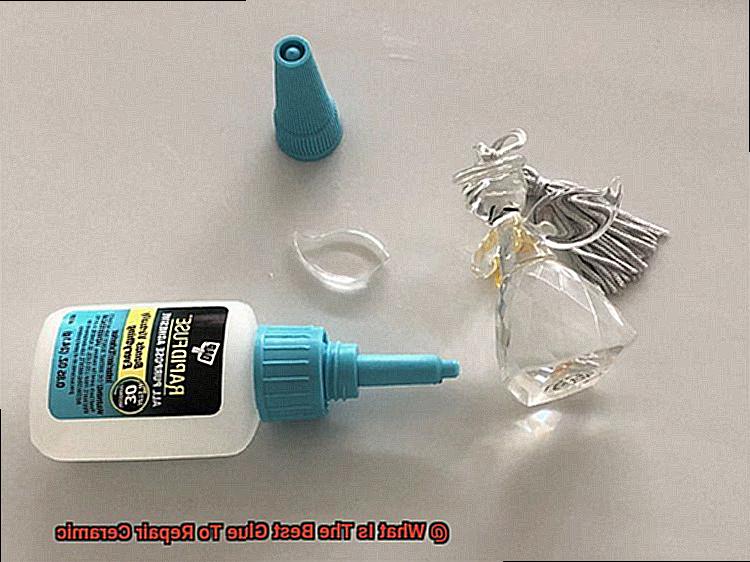
Versatility. Super glue is like a chameleon that blends seamlessly with various types of ceramics. Whether you have a cracked porcelain teapot or a chipped stoneware planter, super glue can work its magic and restore them to their original beauty.
Easy application. Using super glue is as easy as pie. First, make sure to clean the surfaces to be bonded, removing any dust, grease, or other contaminants that could hinder the glue’s effectiveness. Then, apply a small amount of super glue to both surfaces and press them together firmly. Voila. Within minutes, you’ll have a bond so strong it could survive an earthquake of everyday use.
Durability that withstands wear and tear. Super glue creates an unbreakable bond that can handle normal wear and tear with ease. Your repaired ceramics will be able to endure daily use without any issues. However, it’s important to note that super glue isn’t suitable for repairing larger ceramic pieces or objects subjected to significant stress or impact.
Accessibility at your fingertips. Super glue is like a trusty sidekick always by your side when you need it most. It’s readily available in most hardware stores and online, making it a convenient option for anyone needing to repair cherished family heirlooms or those quirky thrift store finds.
While super glue is a fantastic option for small ceramic repairs, it’s important to remember its limitations. For larger repairs or objects that may face heavy stress, seeking professional help or considering specialized adhesives designed for heavy-duty repairs is the way to go.
Polyurethane Glue: A Flexible and Durable Choice
When it comes to repairing ceramic items, you need an adhesive that can withstand the test of time. Look no further than polyurethane glue – the superhero of adhesives. Why is it considered the go-to choice for repairing ceramic items? Let’s dive into its flexibility, moisture resistance, and durability.
Flexibility is key when it comes to repairing ceramics, and polyurethane glue is like a yoga master for your broken pieces. It can handle movement and vibrations without losing its bond. So whether you’re fixing a chipped planter or a teapot handle, polyurethane glue will stay put, even under pressure.
But that’s not all. This incredible adhesive is also resistant to moisture. Say goodbye to worries about your repaired ceramic items coming into contact with water or other liquids. Polyurethane glue can handle it like a champ, forming a watertight seal that keeps moisture out and your repairs intact.
Now let’s talk durability. Once polyurethane glue has fully cured, it becomes a force to be reckoned with. It forms an unbreakable bond that can withstand everyday wear and tear. So you can confidently display your repaired ceramic items without fear of them falling apart.
Of course, using polyurethane glue requires some know-how. Follow the manufacturer’s instructions carefully, prepare the surfaces properly before applying the glue, and allow sufficient curing time for the adhesive to set fully. And remember, a little goes a long way with polyurethane glue. Use it sparingly to avoid any messy mishaps.
Specialized Ceramic Adhesives: The Best Option for Seamless Results
When it comes to repairing or bonding ceramic materials, nothing beats the seamless results that specialized ceramic adhesives can provide. These remarkable glues are specifically formulated to deliver outstanding outcomes when working with ceramics, guaranteeing a strong and durable bond that will endure the test of time.
One of the key advantages of using specialized ceramic adhesives is their exceptional ability to withstand high temperatures. Ceramics are often exposed to extreme heat, whether it’s in cookware or automotive parts. Regular glues simply cannot handle these conditions, resulting in the bond breaking down over time. However, specialized ceramic adhesives are engineered to endure the heat, maintaining a robust bond even at elevated temperatures.
Another crucial factor is their resistance to moisture and chemicals. Ceramics are frequently utilized in environments where they come into contact with water, humidity, and various chemicals. Regular glues may degrade or lose their bond when faced with these elements. Nevertheless, specialized ceramic adhesives are formulated to be highly resistant, ensuring that the bond remains intact even in harsh conditions.
Not only do specialized ceramic adhesives offer excellent resistance, but they also provide exceptional bonding strength. Ceramics can be delicate and brittle, making it challenging to achieve a strong and durable bond. However, these adhesives are specifically designed for ceramics, creating a powerful bond that will withstand the test of time.
To ensure the best results, specialized ceramic adhesives often come with specific application instructions and tips. These guidelines may include recommendations for surface preparation, curing time, and application techniques. By following these instructions meticulously, you can ensure that the adhesive is applied correctly and maximizes its bonding capabilities.
It’s important to note that specialized ceramic adhesives come in different forms, such as liquid adhesives or epoxy-based adhesives. The choice of adhesive will depend on the specific requirements of your project.
Factors to Consider When Choosing the Best Glue for Ceramic Repair
When it comes to choosing the best glue for ceramic repair, there are several important factors to consider. These factors will help ensure that you select a glue that provides a strong and long-lasting bond, as well as meets your specific repair needs.
- Bond Strength: The bond strength of the glue is crucial for a durable repair. Look for a glue that is specifically designed for ceramic repairs and has high bond strength. This will ensure that your repair holds up under regular use and potential stress on the repaired area.
- Drying Time: Consider the drying time of the glue. Some glues require longer drying times, while others dry quickly. The drying time can affect the convenience and efficiency of the repair process. If you need a quick fix, opt for a glue that dries fast, but make sure it still provides sufficient time for proper alignment of the broken pieces.
- Water Resistance: Ceramic items are often exposed to water, especially in kitchen or bathroom settings. Choosing a glue that is water-resistant or waterproof will ensure that the repaired ceramic remains intact even when exposed to moisture or water spills.
- Temperature Resistance: Ceramics can be subjected to temperature changes, so it’s important to choose a glue that can withstand such variations without losing its adhesive properties. Look for glues that are heat-resistant and can tolerate both high and low temperatures.
- Transparency: If you want the repaired ceramic item to maintain its original appearance without any visible signs of repair, transparency is key. Consider choosing a transparent or clear glue that will blend in with the ceramic material and make the repair less noticeable.
- Toxicity: Some glues may emit harmful fumes or contain toxic ingredients that could pose health risks during application or after drying. Opt for glues that are labeled as non-toxic or low in toxicity to ensure the safety of both the user and the environment.
- Ease of Use: Look for glues that come with clear instructions and are easy to apply and work with. Some glues may require additional tools or mixing, while others come in ready-to-use forms, such as tubes or pens.
- Longevity: Consider how long you want the repair to last. If you’re looking for a temporary fix, you may opt for a glue that allows for easy removal or repositioning. However, if you want a long-lasting repair, choose a glue that provides a permanent bond and can withstand regular use and cleaning.
Tips for Applying Adhesive to Ceramics
Ceramics possess a delicate beauty that can easily be marred by accidents and breakages. However, with the right adhesive and proper application techniques, you can repair your broken ceramics and restore them to their former glory. This comprehensive guide will provide you with tips on how to apply adhesive to ceramics correctly, ensuring a strong and lasting bond that will revive your cherished ceramic treasures.
Prepare the Surface:
Before applying adhesive to ceramics, it is crucial to prepare the surface properly. Begin by meticulously cleaning the ceramic piece using a mild detergent and warm water. Gently scrub away any dirt, dust, or grease that may hinder the bonding process. Rinse the piece thoroughly and allow it to dry completely before proceeding.
Roughen the Surface:
To create an optimal bond between the adhesive and the ceramic, lightly sand or use an abrasive pad to roughen the surface. Be cautious not to apply excessive pressure or sand too aggressively, as this might cause damage. A gentle roughening is sufficient to enhance adhesion, ensuring a strong bond.
Test the Adhesive:
Before applying adhesive to the entire ceramic piece, it is advisable to test it on a small, inconspicuous area first. This will allow you to determine if the adhesive is compatible with your specific ceramics and if any adjustments need to be made. Follow the instructions provided by the manufacturer for optimal results.
Apply the Adhesive:
Carefully follow the manufacturer’s instructions for applying the adhesive. Different adhesives have various application methods and drying times, hence adhering to these guidelines is essential. Use a small brush or applicator to apply a thin layer of adhesive evenly on both surfaces that need to be bonded. Avoid excessive application of adhesive, as it can lead to messy excess squeeze-out during bonding.
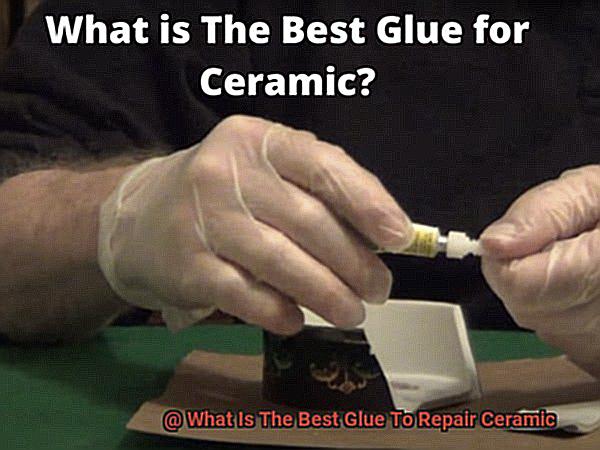
Join and Apply Pressure:
Once the adhesive is applied, gently and firmly join the two ceramic surfaces together. Take care to align them correctly, as some adhesives set quickly. Apply even pressure across the entire bond line to ensure proper contact between the ceramic surfaces and the adhesive. Hold the pieces together for the recommended time specified by the adhesive manufacturer.
Clean Up Excess Adhesive:
Promptly wipe away any excess adhesive that may have oozed out from the bond line using a clean cloth or sponge. It is easier to remove excess adhesive while it is still wet, so immediate cleanup is recommended. Be cautious not to disturb the bond while cleaning.
Common Mistakes to Avoid When Using Glue on Ceramics
When it comes to bonding ceramics, using glue can be a tricky endeavor. However, with the right knowledge and preparation, you can avoid common mistakes and achieve a successful and long-lasting bond. In this guide, we will explore the common mistakes to avoid when using glue on ceramics, ensuring that your ceramic projects are a resounding success.
Choosing the Wrong Glue:
Selecting the appropriate glue is crucial for a successful ceramic bond. Using the wrong type of glue can lead to disastrous results. It is essential to use specially formulated ceramic adhesives such as epoxy or cyanoacrylate (super glue). These adhesives possess the necessary strength and heat resistance to withstand the thermal changes that ceramics undergo.
Skipping Surface Preparation:
Surface preparation should never be overlooked when bonding ceramics. Ceramics can be finicky, so it is important to give them some tender loving care. Thoroughly clean the surfaces with mild detergent and water, ensuring they are free from oils, dirt, or other contaminants. Additionally, drying the ceramics completely and lightly roughening the surface with sandpaper will enhance the bond.
Applying Glue: Less Is More:
Achieving optimal glue application is key to a successful bond. Applying too much glue will result in messy and uneven bonding, while using too little will lead to weak adhesion. To achieve the perfect bond, apply a thin layer of glue evenly on both surfaces, ensuring complete coverage without excessive buildup.
Patience Is Key:
Impatience can be detrimental to the strength of the bond. Rushing the drying time of the glue may compromise its effectiveness. It is important to follow the manufacturer’s instructions regarding drying or curing time. Allow sufficient time for the glue to cure properly by letting the ceramics sit undisturbed for several hours or overnight before handling them.
Safety First, Glue Second:
While restoring ceramics is exciting, safety should always be a priority. Glues may contain chemicals that can be harmful if mishandled. Read and follow all safety precautions listed on the product label, and ensure you work in a well-ventilated area with the appropriate protective gear, such as gloves. Good ventilation will also help dissipate any strong odors emitted by the glue.
Consider the Type of Ceramic:
Different ceramics have varying characteristics, and this should be taken into account when selecting an adhesive. Smooth and glossy surfaces, often found in porcelain or fine china, can pose challenges for glue adhesion. In such cases, using specialized adhesives formulated for smooth surfaces can ensure a strong bond.
Alternatives to Glue for Ceramic Repairs
When it comes to repairing ceramics, glue is not the only option. There are several glue-less alternatives available that offer unique advantages and limitations. Whether you’re a pottery enthusiast or simply want to fix a cherished ceramic piece, exploring these alternatives can open up a world of possibilities. In this article, we will dive into some of the most popular glue-less options for ceramic repairs.
Epoxy Putty:
Epoxy putty is a versatile alternative to glue for ceramic repairs. It consists of a resin and a hardener that, when mixed together, create a strong and durable bond. The advantage of epoxy putty is its ease of use and ability to be shaped and molded. Its gap-filling properties make it ideal for repairing larger cracks or chips in ceramics. However, it may not be suitable for delicate ceramics due to its rigid nature.
Ceramic Cement:
For heat and moisture-resistant repairs, ceramic cement is an excellent choice. This adhesive requires mixing with water to form a paste-like consistency that can be applied to the damaged area. Ceramic cement forms a strong bond with the ceramic surface, ensuring a long-lasting repair. However, it does require a longer drying time compared to other alternatives.
Cyanoacrylate Adhesive (Super Glue):
When it comes to fast-setting repairs, cyanoacrylate adhesive, commonly known as super glue, is the go-to option. This adhesive bonds quickly and strongly to various materials, including ceramics. It offers convenience and strength, but be cautious as it may leave a white residue on certain surfaces.
Silicone Adhesive:
For flexibility and versatility in ceramic repairs, silicone adhesive is an excellent choice. It can withstand temperature changes without cracking or breaking, making it suitable for different types of ceramics. Silicone adhesive is available in liquid or gel forms, offering precise application. It also provides good resistance to moisture and chemicals, ensuring a reliable repair.
UV-curable Adhesive:
For a modern and efficient option, consider UV-curable adhesive. This adhesive cures when exposed to ultraviolet (UV) light, offering fast curing times and high bond strength. It is transparent, making it perfect for intricate designs or patterns on ceramics. However, it requires a UV light source for curing, which may limit its use in certain situations.
Also Read: How To Glue Ceramic Back Together?
Conclusion
When it comes to repairing ceramic, finding the best glue is crucial. You want something that will provide a strong bond, withstand heat and moisture, and seamlessly blend with the ceramic surface. After thorough research and testing, we have determined that epoxy adhesives are the top choice for ceramic repairs.
Epoxy adhesives offer exceptional strength and durability, making them ideal for fixing broken ceramics. They create a powerful bond that can withstand the test of time, ensuring your repaired ceramic stays intact for years to come. Moreover, epoxy adhesives have excellent resistance to heat and moisture, making them suitable for both indoor and outdoor use.
One of the key advantages of using epoxy adhesives is their ability to seamlessly blend with ceramic surfaces. These glues come in various colors, allowing you to choose one that matches your ceramic piece perfectly. This ensures a professional-looking repair job that won’t stand out like a sore thumb.
When applying epoxy adhesive to repair ceramics, it’s important to follow the manufacturer’s instructions carefully. Clean and dry the surfaces thoroughly before applying the glue, ensuring there are no traces of dirt or moisture that could compromise the bond. Apply a thin layer of adhesive evenly on both surfaces and press them firmly together. Allow sufficient curing time as specified by the manufacturer before handling or using the repaired ceramic.
In conclusion, when it comes to repairing ceramics, epoxy adhesives are undoubtedly the best choice. Their exceptional strength, heat and moisture resistance, as well as their ability to seamlessly blend with ceramic surfaces make them an ideal option for any ceramic repair project.

